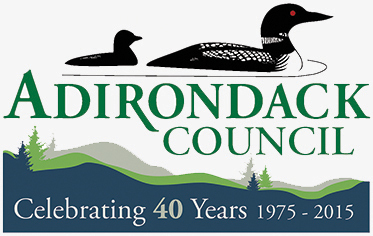
Adirondack Council Praises State's Pro-Adirondack Budget

Adirondack Council Praises State's Pro-Adirondack Budget
Pleased with Clean Water Infrastructure, Land Protection, Stewardship,
Invasive Species Controls, Community Planning & State Staffing;
Disappointed with Green Energy Fund Raid
For more information:
John F. Sheehan
518-441-1340 (cell)
518-432-1770 (ofc)
FOR IMMEDIATE RELEASE, Tuesday, March 31, 2015
ALBANY, N.Y. – The NYS budget for the next fiscal year includes much-needed investments in clean water, wilderness, wildlife and communities of the Adirondack Park, including a three-year, $200-million capital program to repair wastewater treatment and drinking water facilities, the Adirondack Council said today.
Under the three-year capital investment plan, the state would set aside $50 million this year and $75 million in each of the next two fiscal years to pay for matching grants to communities for up to 60 percent of upgrades for local drinking water and wastewater treatment facilities.
“This kind of investment in clean water systems can help small Adirondack Park communities rebuild facilities to better handle local business, residents and 10 million annual visitors,” said Adirondack Council Executive Director William C. Janeway. “We have world-class scenery and recreational opportunities in the Adirondacks, but we don’t yet have the world-class drinking water and wastewater treatment systems we need to protect the environment and public health. This will help wildlife, communities, clean water, and wilderness.
“This new program offers hope to small, Adirondack communities that qualify for clean water loans from the state but can’t afford to repay multi-million-dollar debts,” Janeway explained. “Now they can get up to $5 million in grants and significantly reduce what they must borrow.”
Janeway said the budget also included an increase of $15 million in the Environmental Protection Fund (EPF) above last year, for a total of $177 million. The EPF appropriations include an increase of $7.4 million for capital projects in the four Adirondack high-priority areas of open space protection, smart growth planning, invasive species controls and public land stewardship. EPF supporters had requested $200 million.
The unwelcome element of the budget was $41-million raid on the Regional Greenhouse Gas Initiative (RGGI) green energy fund, diverting it into the state’s General Fund, Janeway explained. The RGGI program is a nine-state cooperative pollution control program aimed at reducing carbon emissions from electric power plants.
“RGGI proceeds are supposed to be spent on clean energy development and energy conservation programs, combating climate change,” Janeway said. “Climate change is a significant threat to the Adirondack Park’s environment and economy. Addressing that threat must remain a priority.
“Next year’s budget goal is another step toward a $300-million, fully funded EPF,” Janeway explained. “That should include full EPF funding with Real Estate Transfer Tax revenue, as well as repayment of the RGGI raid.
“The Adirondack Council recognizes and applauds the efforts of Governor Cuomo and his team, the NYS Senate and Assembly, in particular Environmental Conservation chairs Thomas F. O’Mara and Steven Englebright, Sen. Betty Little and others from the North Country and across the state, and many organizations who also worked on these issues,” Janeway said.
For the remainder of this year, there is much that still remains to be done to protect the Park’s fragile environment and assist its rural communities. Issues that should be addressed before the Legislature adjourns on June 17 include off-road motorized vehicles, science-based reforms at the Adirondack Park Agency, community infrastructure, wild lands protection and updates to private forestry and land-stewardship incentives.
Budget highlights include:
Environmental Protection Fund: Total increased from $162 million to $177 million; includes an increase of $4.9 million for Open Space (total $26.5 million); public Land Stewardship increased by $1.15 million to $18.5 million; Smart Growth planning grants to communities went up from $400,000 to $600,000; and, Invasive Species control programs increased by $1.15 million to $5.85 million, to a new Adirondack Park wide invasive species prevention strategy.
DEC increased staffing: Staffing increased by 36 including spill response, habitat protection and a new Office of Public Protection (OPP) academy for Forest Rangers and Environmental Conservation Officers. No movement on restoration of Adirondack Park Agency staff.
Oil Spill Fund: New York’s $25-million, Comptroller-managed fund that would help communities deal with a spill, fire or explosion (or all three) from an oil train derailment (or other source), was increased to $40 million. Up to $2.1 million per year of that was authorized for prevention and emergency response training. Canadian Pacific trains carry millions of gallons of crude oil through the Adirondack Park each day on more than 100 miles of track running along the edge of Lake Champlain.
License and Permit Fees: DEC Permit fees for discharge of air and water pollution were increased; DEC sporting license fees were dedicated to wildlife programs, per federal requirements.
Broadband funding to solve “the last mile:” $500 million to be used as 1:1 public/private match for broadband projects. Matching should allow state to leverage more co-location in the Park and encourage investment in providing service to less-populated areas.
Upstate Revitalization Fund: $1.5 billion towards three (3) awards worth $500 million each to be awarded amongst the seven (7) upstate REDC regions with transformative economic growth projects. The North Country should be well-positioned to fare well in competition, and clean water projects would qualify for this funding.
Superfund & Brownfields program reform and extension: Program extended with an additional commitment of $1 billion over 10 years. This could help Adirondack communities such as Clifton & Fine (St. Lawrence County), which are trying to clean up and redevelop brownfield/superfund sites.
The Adirondack Council’s mission is to ensure the ecological integrity and wild character of New York’s six-million-acre Adirondack Park. The Council envisions an Adirondack Park comprised of core wilderness areas, surrounded by working forests and farms, and vibrant rural communities. Adirondack Council members live in all 50 United States.




